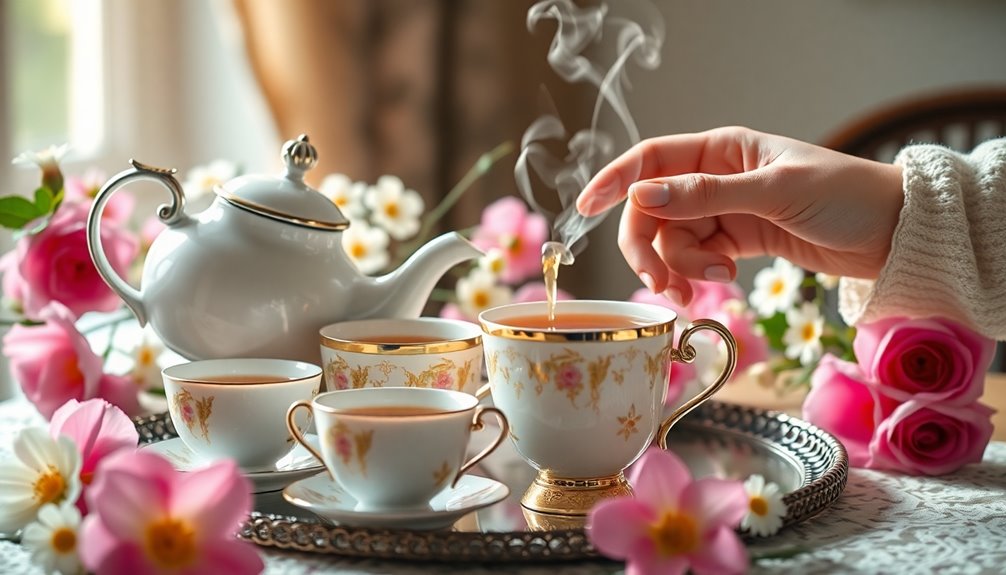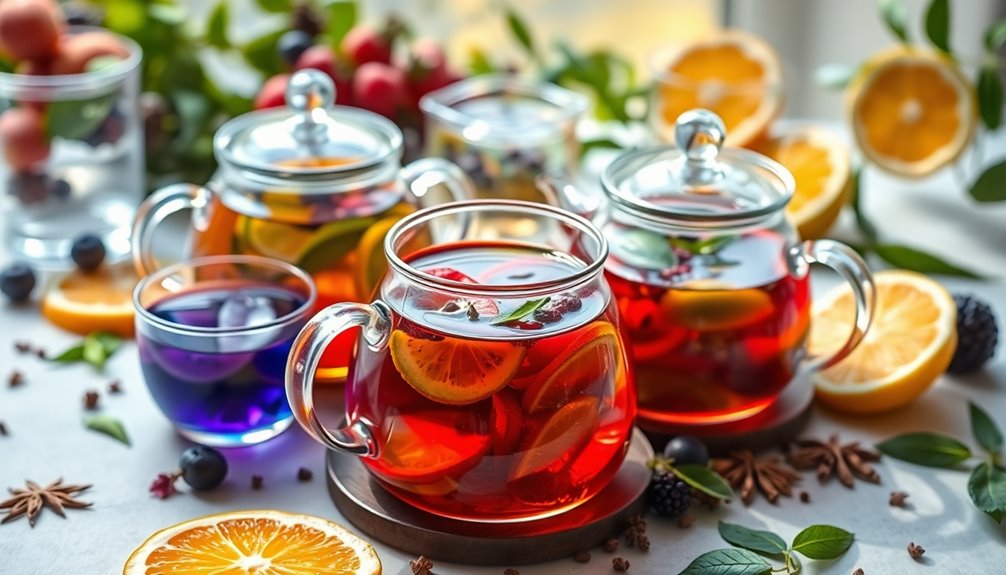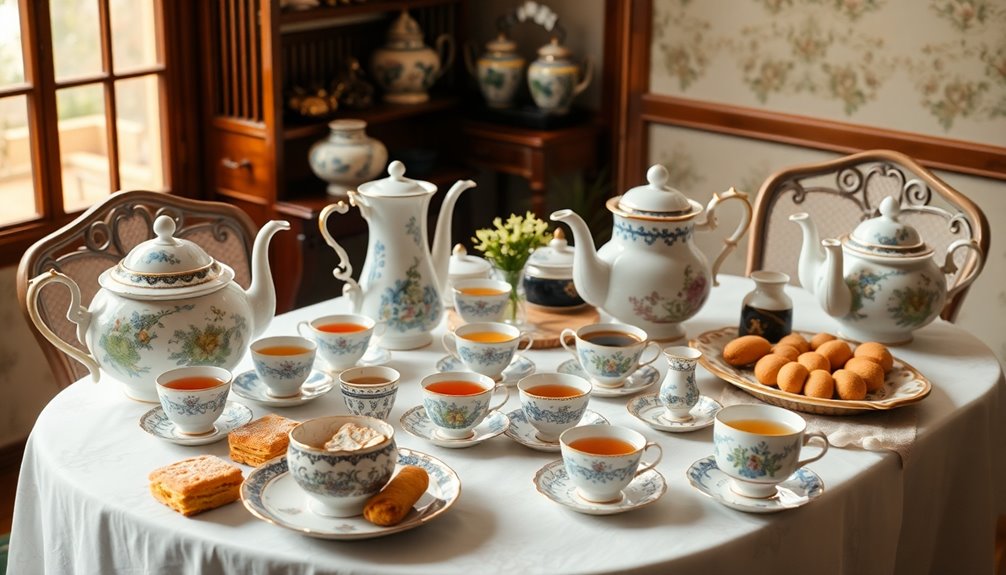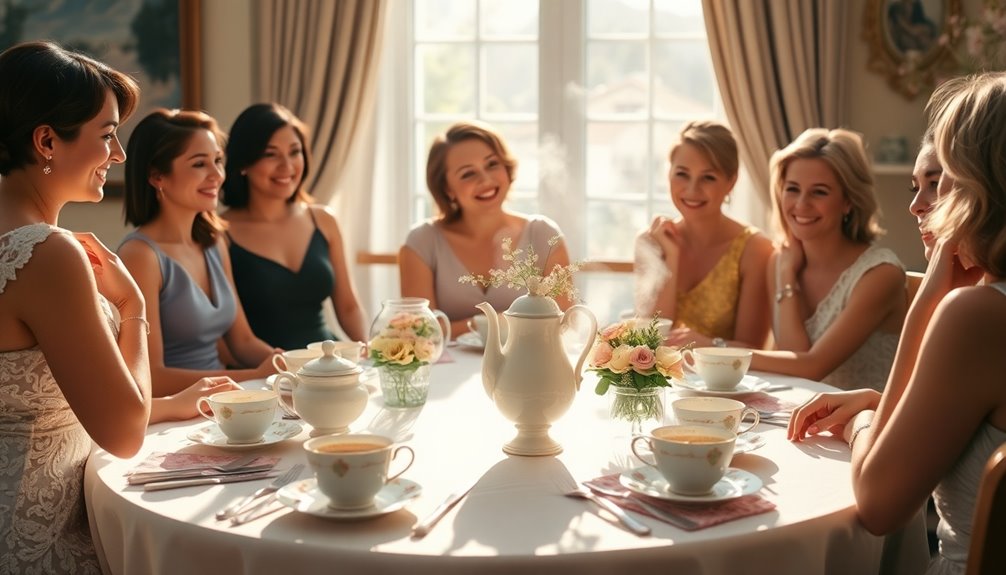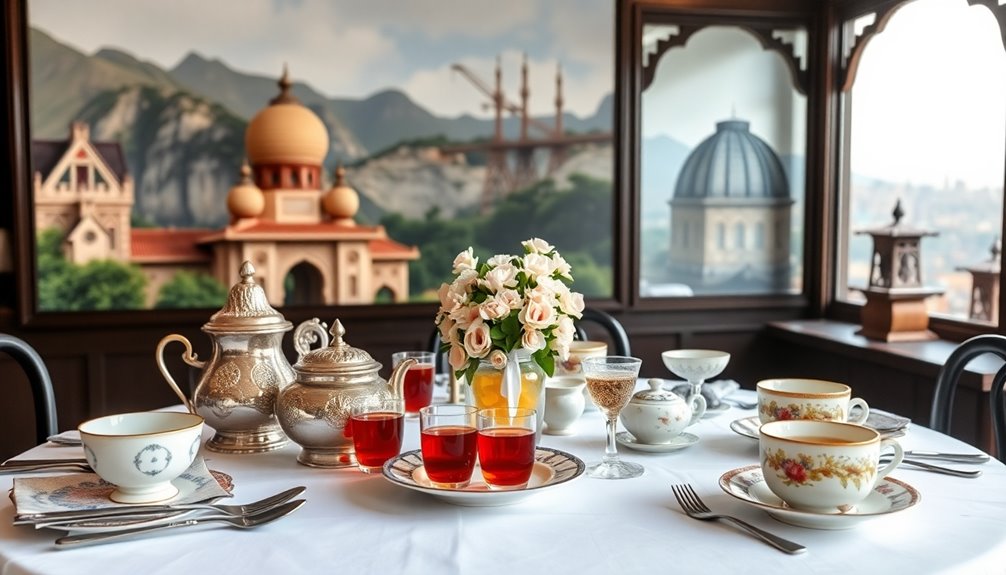To perfect your tea serving, start by using a teapot with a strainer to ensure a smooth pour. Fill each cup about three-quarters full to allow for unique customization. When passing the cup, hold both the cup and saucer together for elegance. Grip the teapot securely—one hand on the handle and the other on the lid—to avoid spills, and maintain a steady pour to enhance the experience. Remember, the temperature at which you brew each type of tea matters too. Stay tuned to discover more insightful techniques that will elevate your tea gatherings!
Key Takeaways
- Use a teapot and strainer for loose leaves to ensure a smooth tea experience.
- Pour each cup individually, filling three-quarters full to allow customization for guests.
- Hand both the cup and saucer together to enhance elegance and ease of use.
- Hold the teapot securely with one hand on the handle and the other on the lid to prevent spills.
- Maintain a steady pour to enrich the overall tea-drinking experience.
Introduction
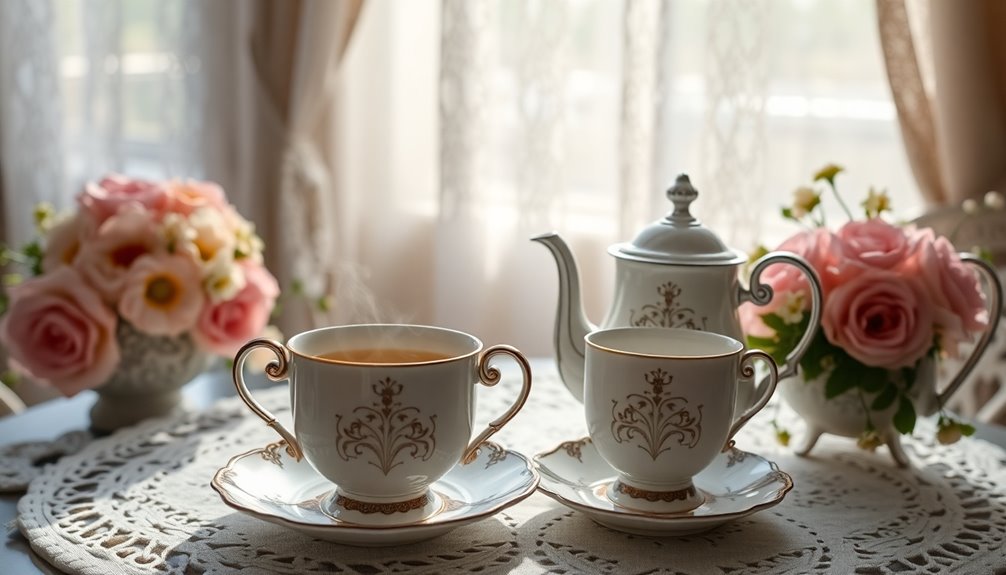
When it comes to serving tea, the experience can be just as important as the beverage itself. You want your guests to feel special, particularly the guest of honor, so consider your pouring method carefully.
Start by using a teapot and a strainer to keep loose leaves out of the cup of tea. This ensures a smooth drinking experience that highlights the tea's flavor.
Pour each cup one at a time, filling it about three-quarters full. This leaves room for milk or lemon, letting your guests customize their drinks to their liking.
When it's time to pass the teacup, make sure to hand both the cup and saucer together. This not only looks elegant but also makes it easier for your guests to handle.
While pouring, hold the teapot securely with one hand on the handle and the other on the lid. This prevents spills and maintains the tea experience's integrity.
History of Tea Serving Traditions
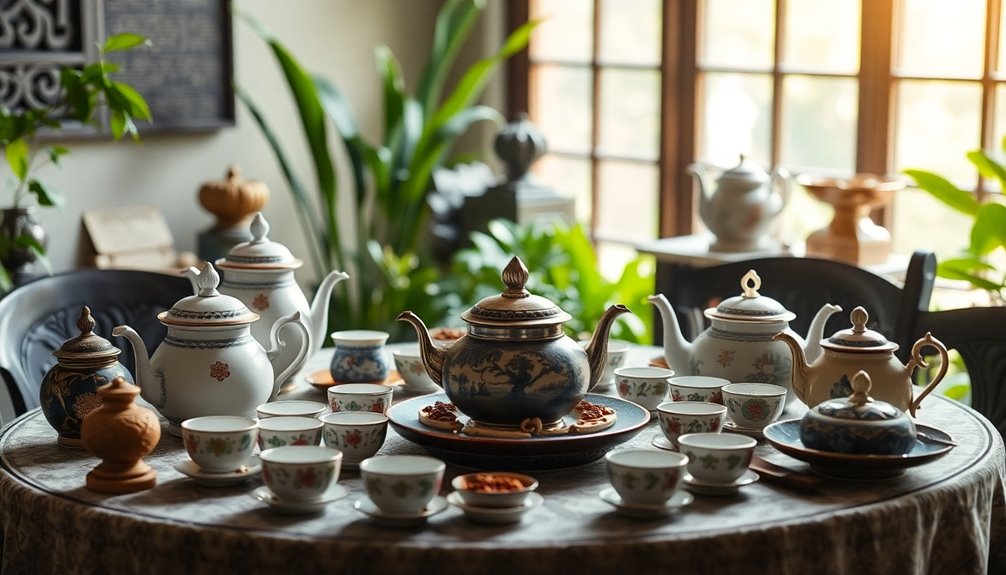
Tracing back to the 17th century, tea serving traditions have evolved dramatically, particularly in England, where it became a symbol of sophistication among the aristocracy.
As tea gained popularity, formal tea rituals emerged, leading to the delightful tradition of tea parties. One standout moment in this evolution was the introduction of Afternoon Tea by Anna, the Duchess of Bedford, in the early 1840s. She cleverly created a social event to bridge the gap between lunch and dinner, serving loose leaf tea alongside an array of sweet and savory treats.
During this period, the iconic tea set became essential for hosting, showcasing fine china and elegant teapots.
While many associate high tea with afternoon gatherings, it actually served as a substantial meal for the working class, featuring hearty dishes alongside English Tea.
The practice of adding milk to tea, which started in the 18th century, not only softened the strong flavors but also protected delicate porcelain cups from cracking.
These traditions, from the elegance of Afternoon Tea to the rich history of Japanese tea ceremonies, continue to shape how we experience tea today.
Tea Serving Temperature Matters

Serving tea at the right temperature is crucial for unlocking its full flavor potential. Each type of tea has its ideal brewing temperature, which directly influences the tea's flavor during steeping.
For strong tea like black tea, you should brew it at temperatures between 200°F to 212°F (93°C to 100°C). This ensures a robust extraction of its rich flavors. On the other hand, green tea requires a gentler touch, steeping it at lower temperatures around 160°F to 180°F (71°C to 82°C) to avoid bitterness and preserve its delicate taste.
Oolong tea thrives at a brewing temperature of about 190°F to 200°F (88°C to 93°C), which allows its complex flavors to shine. When it comes to white tea, aim for 160°F to 185°F (71°C to 85°C) to keep its subtle notes intact.
Herbal teas, often caffeine-free, can handle boiling temperatures of 200°F to 212°F (93°C to 100°C) to fully extract their rich flavors and health benefits.
Cultural Significance of Tea Serving

Tea holds a profound cultural significance in many societies, serving as a bridge for connection and hospitality. When you gather for tea time, it's not just about sipping; it's about the experience you create with those around you. The strength of the tea you serve can convey your attention to detail and your respect for your guests. Each cup of tea represents an opportunity to connect, share stories, and strengthen relationships.
The rituals of tea serving, like stirring the tea with care or presenting it in beautiful cups, emphasize thoughtfulness. In cultures worldwide, these practices reflect values of respect and mindfulness, especially in ceremonies such as the Japanese tea ceremony. Here, every movement is deliberate, showcasing the cultural significance of tea as more than a beverage.
Moreover, tea serving often fosters communal interaction, allowing conversations to flow naturally. As you pour and share, you're not just serving tea; you're nurturing bonds and creating a shared moment of joy.
Cultural Appropriation in Tea Practices
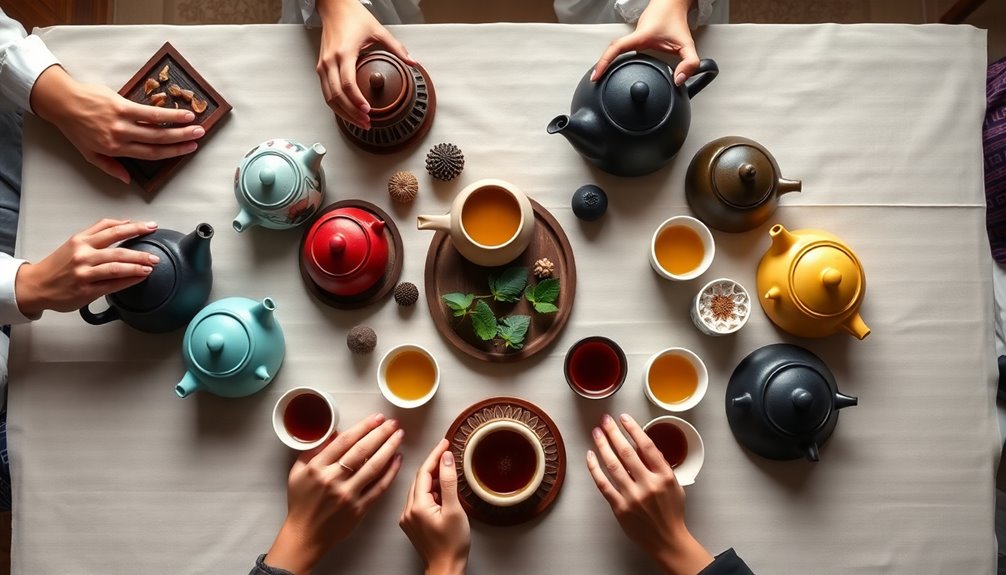
Many people enjoy exploring different tea traditions, but it's crucial to approach these practices with respect and understanding. Cultural appropriation in tea practices happens when individuals or groups adopt elements from a culture's tea traditions without grasping their origins and significance.
For example, the rich history of tea drinking in ancient China reveals that tea wasn't just a beverage; it played a vital role in social and spiritual rituals. When Western adaptations, like high tea or afternoon tea, emerge, they often strip away the communal aspects and depth found in original practices from countries such as China and Japan.
This misunderstanding can lead to a superficial adoption that overlooks the proper rituals, customs, and etiquette integral to those traditions. To engage respectfully with another culture's tea practices, you need to acknowledge their historical context and significance.
This approach fosters appreciation rather than appropriation, ensuring that you honor the ongoing traditions upheld by that culture's people. By doing so, you can enjoy tea not just as a beverage but as a meaningful experience that connects you to the heritage and rituals of others.
Practical Applications

A well-executed tea service can elevate the entire experience for your guests. To achieve this, use a two-teapot method: one pot for steeping and another for pouring. This ensures that you present the best tea without any fuss. Additionally, the caffeine content in different types of tea can influence your guests' preferences, so it's good to know their choices.
When you're pouring, hold the teapot by the handle with one hand and hold the lid with your other hand to prevent spills and maintain control.
Always serve tea with a cup and saucer, placing the spoon on the saucer. This encourages gentle stirring while minimizing noise, enhancing the ambiance.
If you're serving loose tea, position a strainer on the cup's edge before pouring to catch any leaves. After pouring, shake it gently to remove excess drops.
Be attentive to your guests' preferences. For those who love a bit of zest, offer lemon slices alongside milk and sugar. Remember, it's about making each guest feel special. Additionally, serving tea in a well-ventilated area can help ensure improved indoor air quality for a more enjoyable experience.
Conclusion
In conclusion, mastering the art of tea serving enhances not just the drink itself but the entire experience. By understanding the history, temperature, and cultural significance behind each cup, you're honoring traditions while enjoying a timeless ritual. Remember to respect the diverse practices and be mindful of cultural appropriation. As you perfect your pouring techniques, you'll create a welcoming atmosphere that invites connection and conversation, turning every gathering into a memorable tea experience.

